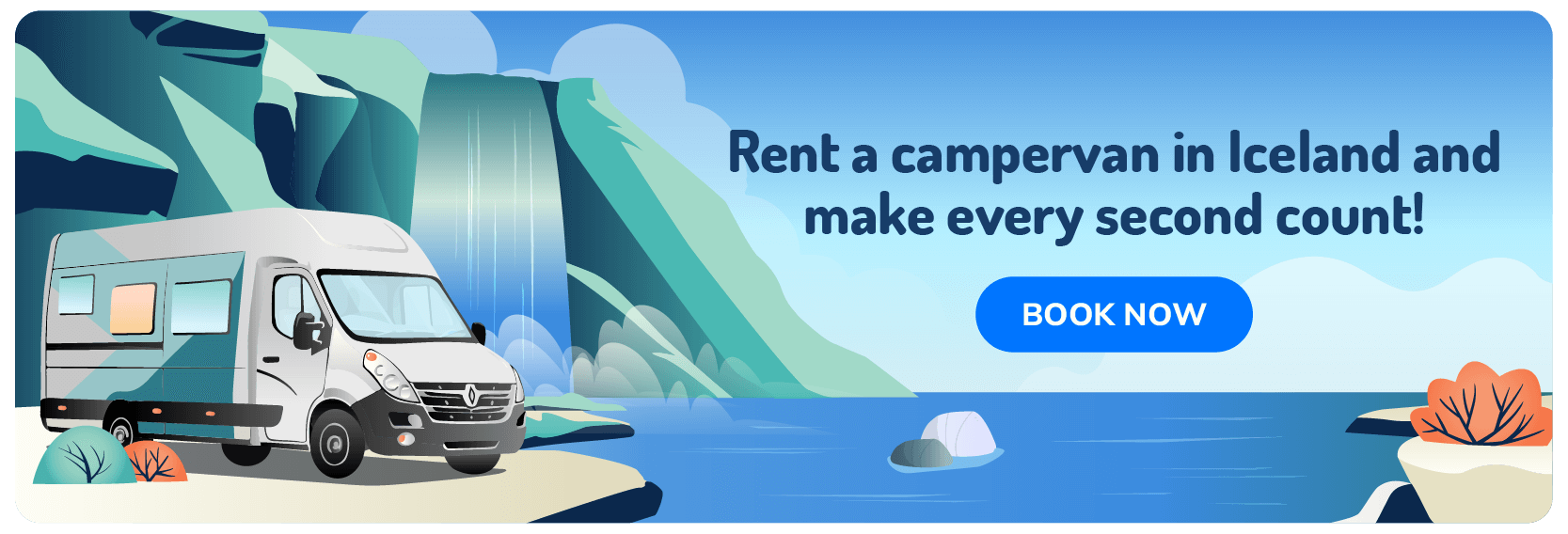Did you know Iceland serves up northern lights for up to eight months a year? That’s a long season, but seeing them isn’t as easy as pulling over and looking up. You need the right timing, clear skies, and a solid plan.
A campervan rental in Iceland gives you the best chance to chase the aurora, dodge bad weather, and escape light pollution. But when should you go? This guide breaks down the best time to see the northern lights in Iceland, the best campsites for viewing, and tips to stay warm and ready. Because nothing ruins the moment faster than missing the show or freezing in the dark.
When Is the Best Time to See the Northern Lights in Iceland?
If you're dreaming of seeing the northern lights, let's talk about the best time to visit Iceland for the northern lights. Between September and early April, Iceland's long, dark nights set the stage for this magical phenomenon. December and January are your best bets for the longest nights, while September, October, March, and April give you a good mix of decent weather and enough darkness to spot the aurora.
Now, here's what's happening up in our skies. The northern lights occur when charged particles from the sun collide with gases in Earth's atmosphere. These cosmic collisions create stunning colors, mostly green, with hints of pink and purple, lighting up the night like nature's own disco. It's all thanks to solar wind and Earth's magnetic field.
To make the most of it, find a spot with clear skies and zero light pollution. Check the KP index, which rates aurora activity, and aim for a 4 or higher. Trust us, it's worth the effort to escape city lights for this unforgettable show.
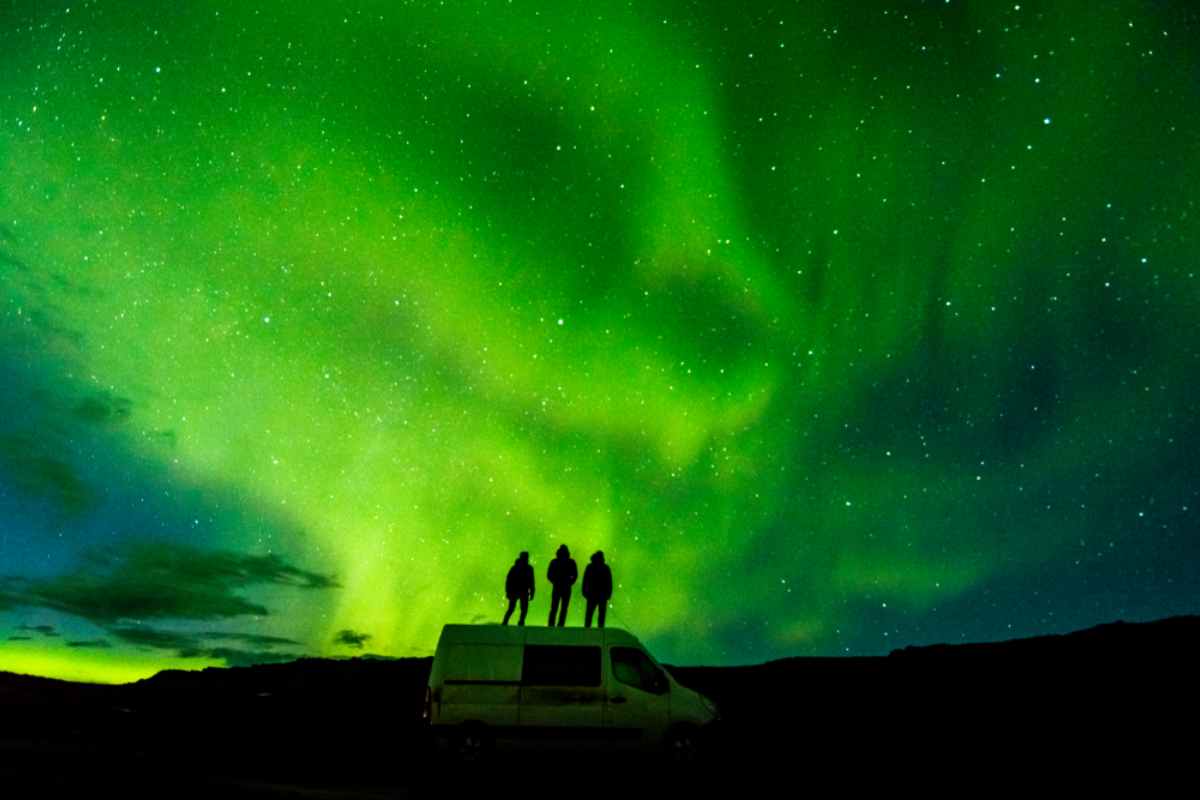
Northern Lights Tours vs. Campervan Travel: Which One Is Right for You?
If you want to see the Northern Lights, then the two best options we would say are either booking a guided tour and letting someone else handle the details or taking a campervan and chasing the aurora at your own pace. One is easy. The other is an adventure.
Why Choose a Campervan?
- Go wherever the forecast looks best instead of being stuck with one location.
- Stay as long as you want instead of following a strict schedule.
- Wake up under the aurora instead of driving back to a hotel.
- Requires driving and flexibility, but the freedom is worth it.
Why Choose a Guided Tour?
- No driving, no stress, just sit back and enjoy.
- Local guides know the best viewing spots and check forecasts for you.
- Limited time at each stop, and if the lights show up late, the tour won’t wait.
Top Northern Lights Tours
- Northern Lights Super Jeep Tour – Small groups and off-road access. [Book here]
- Northern Lights Boat Tour – View the aurora from the open sea. [Book here]
Iceland Northern Lights Season: A Month-by-Month Breakdown
To give you a better idea of what to expect, we'll break down each season and the pros and cons that come with it.
Autumn (September to November): The Early Viewing Window
Autumn in Iceland is the early viewing window for the northern lights, and it has its own unique charm. If you're wondering about the best month to see northern lights in Iceland, September is a top pick.
It offers the perfect mix of longer daylight hours for exploring Iceland's stunning landscapes and milder temperatures that make outdoor activities more enjoyable. Imagine hiking during the day and chasing the aurora at night.
But, as with anything in Iceland, autumn weather can be unpredictable. Occasional storms might roll in, sometimes obscuring the night sky. That's just part of the adventure, right?
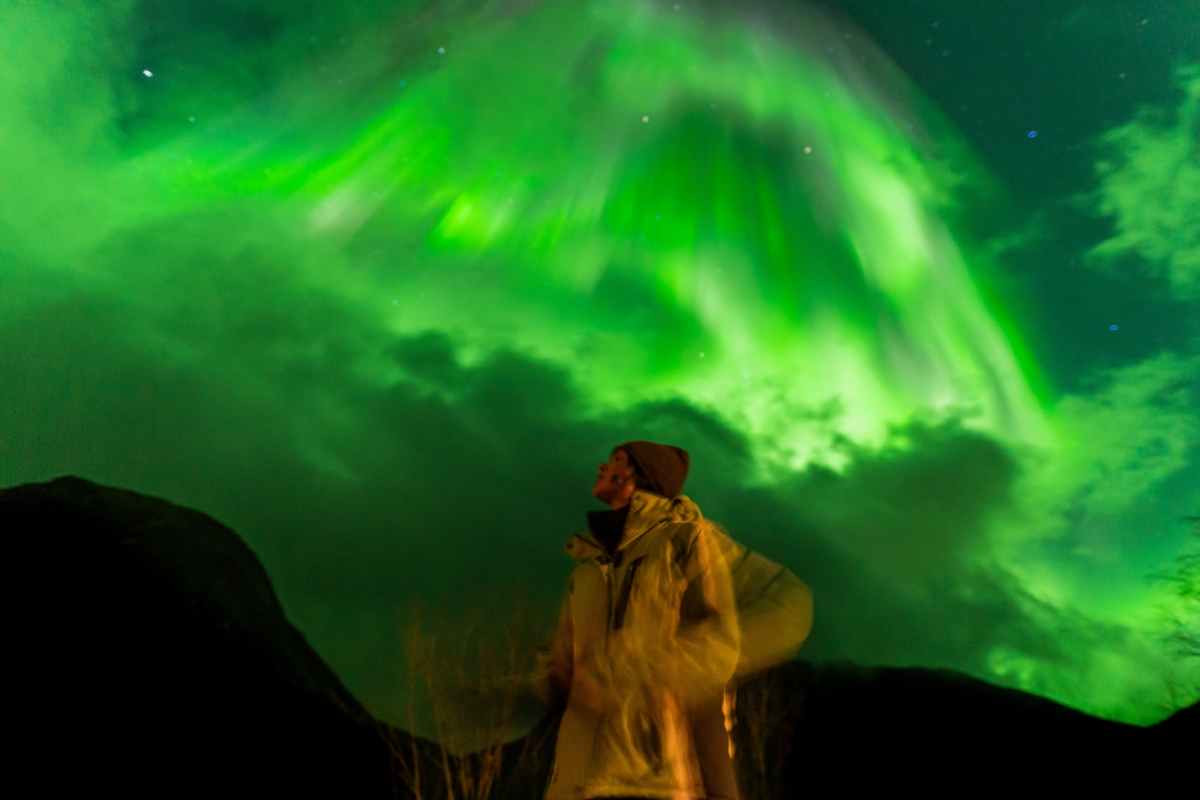
Winter (December to February): Peak Season for the Northern Lights
Winter is the heart of Iceland's northern lights season, offering some of the best opportunities to catch this incredible phenomenon. December and January are standout months, boasting the longest nights of the year, which means more time under the stars.
January is also known for its relatively stable weather, giving you a better chance of clear skies to spot those magical auroras. Of course, winter isn't without its challenges. Severe weather, icy roads, and unexpected closures can make travel tricky.
But isn't that all part of the Icelandic experience? Just be prepared, dress warmly, and keep an eye on the forecasts. For the best viewing, aim for the hours between 10 PM and midnight. This is when auroral activity typically peaks, giving you the highest chance of seeing the lights dance across the sky.
Spring (March to Early April): Final Chance Before Summer
Spring offers your final chance to see the northern lights in Iceland before the midnight sun takes over. If you're asking about the best time to go to Iceland for the northern lights, March and early April are excellent choices. The skies often clear up during this time, increasing your chances of spotting the aurora.
Plus, the longer daylight hours mean you can pack in more activities before settling in for some nighttime magic. Spring is perfect for combining aurora hunting with some of Iceland's best experiences. Spend your days hiking beautiful trails that are beginning to thaw and reveal Iceland's breathtaking landscapes.
Afterward, soak in one of the country's many hot springs, letting the geothermal warmth melt away the chill of the night. For photography enthusiasts, this season is a dream, with opportunities to capture the northern lights dancing over dramatic landscapes. It's a season of adventure and awe rolled into one.

Best Places to See the Northern Lights in Iceland
So, now you know all about the best time to see the northern lights in Iceland, but where should you go to catch the show? Here are a few of our top picks outside of Reykjavik:
Thingvellir National Park (Golden Circle)
If you're planning to chase the northern lights, Thingvellir National Park is one of the best spots to visit in Iceland. It is close to Reykjavik, about 44 kilometers (27 miles) northeast, and far enough from city lights to give you those perfectly dark skies you need.
This UNESCO World Heritage Site is not only stunning but also historically significant as the original site of Iceland's parliament, the Alþingi, which was established in 930 AD. The park's rift valleys and dramatic landscapes make for an unforgettable backdrop to watch the northern lights.
If you are out between 10 PM and midnight on a calm, clear night, your chances of seeing the lights are even better. Thingvellir also has convenient parking and elevated viewpoints, so finding a great spot to watch the sky light up is easy.
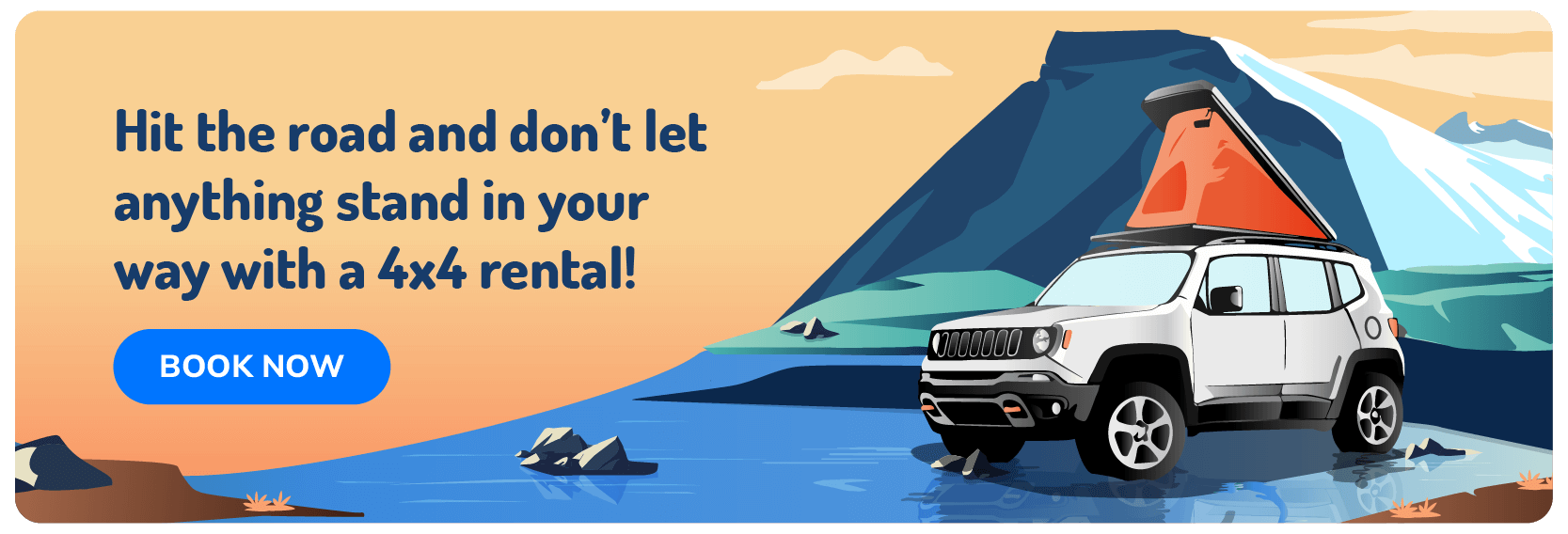
Snæfellsnes Peninsula
The Snæfellsnes Peninsula is one of the best places to see the aurora in Iceland. Located in the western part of the country, it combines stunning natural beauty with some of the darkest skies you'll find, making it a perfect spot for northern lights viewing.
Some key spots to check out include the coastal areas near Arnarstapi and the Svörtuloft Lighthouse. These areas are far from artificial lights, giving you a clear view of the night sky. The peninsula's rugged terrain, with volcanic mountains and dramatic coastlines, adds an extra layer of magic to the experience.
You can also join guided tours that mix northern lights hunting with exploring local attractions, making the trip even more memorable. With its remote location and breathtaking scenery, the Snæfellsnes Peninsula is undoubtedly one of Iceland's top spots for experiencing the magic of the aurora borealis.
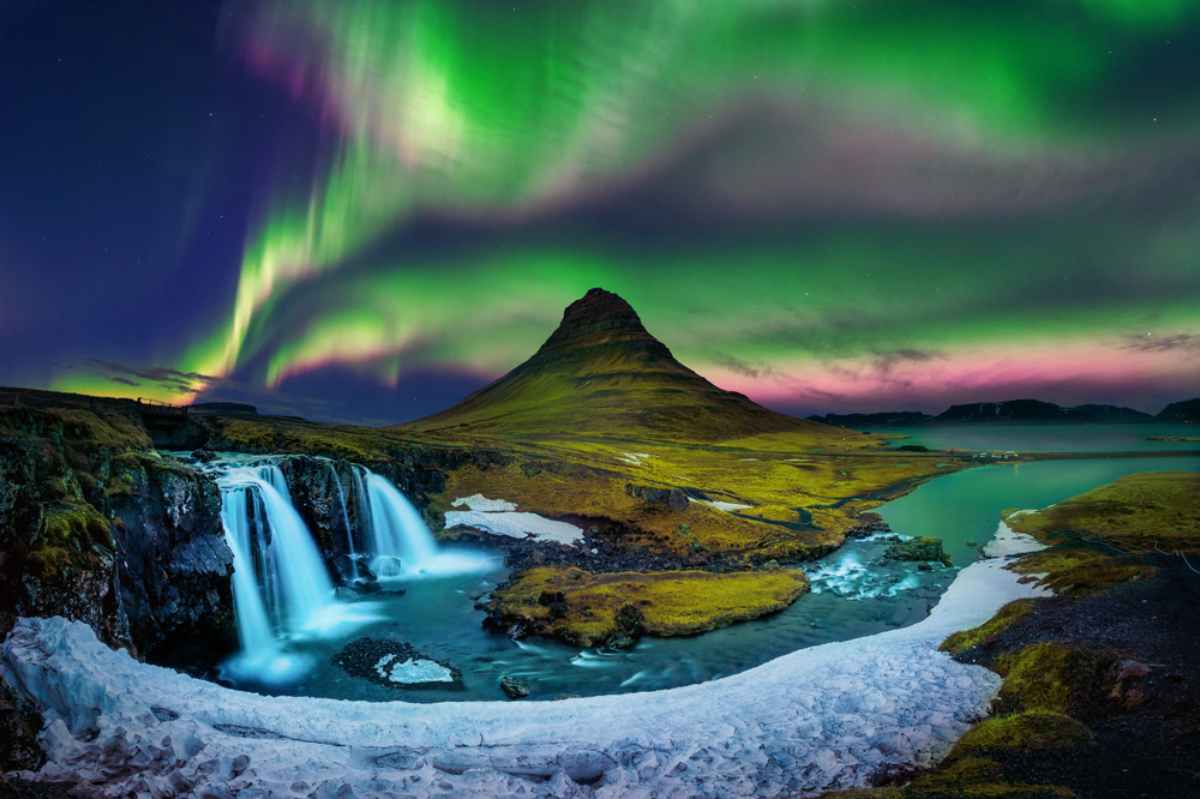
Vik's Black Sand Beaches
Vík's Black Sand Beaches are such an amazing spot if you're hoping for a good chance of seeing the northern lights. Down on Iceland's southern coast, Vík is famous for its stunning black sand beaches like Reynisfjara. The view here is unreal, with a wide-open horizon that's perfect for catching the aurora.
The dark sands and those epic basalt cliffs make the perfect backdrop for the lights. Plus, with a 360-degree view of the sky and barely any light pollution, your chances of spotting the northern lights are pretty solid. It's also a dream for photographers who want to capture something truly special.
If you're planning to chase the northern lights, Vík's Black Sand Beaches should definitely be on your list. It's one of those places that feels like a scene out of a movie.
Jökulsárlón Glacier Lagoon
Jökulsárlón Glacier Lagoon is one of the most magical places to experience the northern lights. Tucked away in southeast Iceland, this glacial lagoon is filled with huge, glittering icebergs that float peacefully on the water, creating a stunning backdrop for the auroras.
Since it's so remote, there's barely any light pollution, making it one of the best spots to see the northern lights dancing across the sky. Nearby, Diamond Beach adds even more magic to the experience, with ice chunks scattered across black sand that sparkle under the aurora's colors.
To make the most of your visit, you can join a guided tour. They'll give you expert tips and help you catch the lights at the perfect time.

Where Can You See the Northern Lights in Reykjavik?
So, can you see the northern lights in Reykjavik? The answer is yes, but you need to pick the right spots. Light pollution in the city can make it tricky, but places like Seltjarnarnes Nature Reserve are perfect for escaping the city glow.
It's just a short drive from the center and offers dark skies with open views, ideal for spotting the aurora. Another great option is Videy Island. Hop on a quick ferry ride, and you'll find yourself surrounded by calm, dark skies that make it easier to catch the lights. Both spots are close enough for convenience but feel worlds away.
How to Plan for the Best Northern Lights Experience
Planning for the northern lights in Iceland is all about timing, preparation, and flexibility. Here are some useful tips to help you make the most of your trip:
- Best time of night: The auroras are most active between 10 PM and 2 AM, so plan to stay up late. Bring some snacks and a thermos of hot chocolate to keep the vibe cozy while you wait.
- Aurora forecast tools: Download apps like Aurora Forecast Iceland. They'll give you updates on the KP index, which shows auroral activity, and cloud cover forecasts so you can plan where to go.
- Weather conditions: Clear skies are essential. Be ready to adjust your plans if the forecast changes, and try to stay flexible with your schedule.
- Clothing: Iceland's winter is no joke. Layer up with thermals, waterproof gear, gloves, a hat, and sturdy boots. Staying warm means you can fully enjoy the show without cutting the night short.
- Tours or self-driving: Small group tours are ideal for expert guidance and ease. If you like to explore on your own terms, self-driving gives you the freedom to chase the lights wherever they appear.
Tips for Photographing the Northern Lights
Photographing the northern lights can feel like a dream, but with the right tips, you can capture those magical colors perfectly. Here's how to make sure your shots stand out when you go to catch the northern lights:
- Camera settings: Start with an ISO between 800 and 1600 to keep your photos bright without too much grain. Set your shutter speed between 10 to 20 seconds, depending on how fast the lights are moving. For focus, switch your lens to manual and adjust until the stars are sharp.
- Best gear: A sturdy tripod is your best friend. It keeps your camera steady during those long exposures. A wide-angle lens is also a must for capturing as much of the sky as possible, along with some of the stunning Icelandic landscape.
- Ideal locations: Glacier lagoons and black sand beaches are unbeatable for creating reflection shots. The icy waters of Jökulsárlón or the glossy sands of Reynisfjara add extra depth and drama to your photos.
Most importantly, take your time, experiment with settings, and enjoy the experience. The northern lights are fleeting, but with the right preparation, you'll have photos that make the moment last forever.
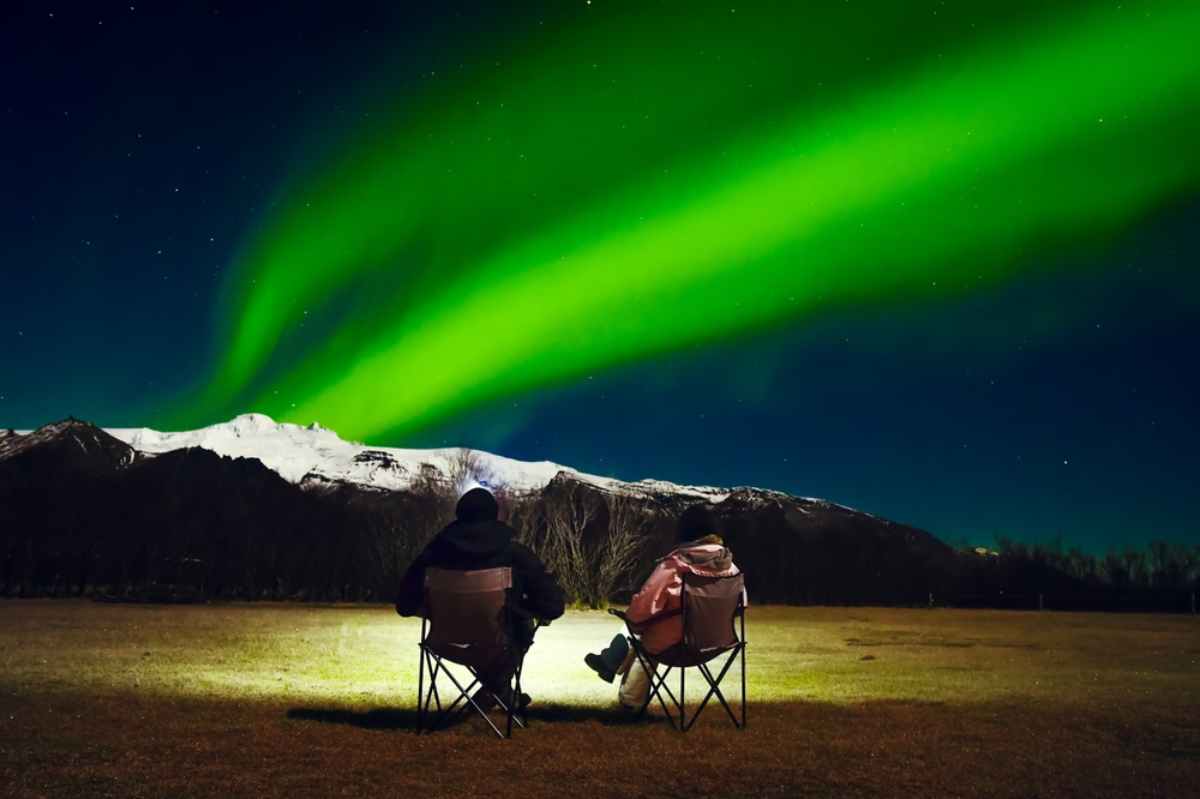
Renting a Campervan for the Northern Lights
With our campers, you can chase clear skies, escape light pollution, and park exactly where the aurora is strongest.
Why choose Motorhome Iceland?
- Winter-Ready Campers – Fully insulated and heated, designed to keep you warm no matter how cold it gets.
- 4x4 Options – Go beyond the usual tourist spots and find the best northern lights locations, even on rough roads.
- Sturdy Roof Tents – Made from thick fiberglass, they withstand strong winds and provide top-notch thermal insulation for a comfortable night under the stars.
- Winter Tires Included – We throw them in free of charge, so you get better grip and safer driving on Iceland’s icy roads.
- Unlimited Mileage – Drive wherever the forecast says the lights will be brightest, with no restrictions.
- All-in-One Comfort – Our campers come with cozy beds, cooking gear, and plenty of storage, so you can stay off-grid as long as you like.
Book your campervan in Iceland now before it's too late!
Which Campervan is Right for Your Northern Lights Trip?
Not all campervans are created equal, and the last thing you want is to realize halfway through your trip that you picked the wrong one. Some are built for icy mountain roads, while others are better suited for a smooth and cozy ride. Here are the models of campervans we have up for grabs and which one will be best suited for your needs.
Best Budget-Friendly Options
If you’re looking for an affordable way to explore without freezing or feeling like a sardine, these are solid picks.
- Dacia Duster 4x4 Roof Tent (Manual) – Small but mighty, this one lets you tackle F-Roads without emptying your wallet. The fiberglass roof tent keeps you warm, even when the temperature decides to ruin your night.
- VW Caddy Camper (Manual or Automatic) – A cozy little van with just enough space for two. Great for paved roads and anyone who prefers their campervan experience without shifting gears every five seconds.
Best for: Travelers who want to save money but still wake up somewhere better than a parking lot.
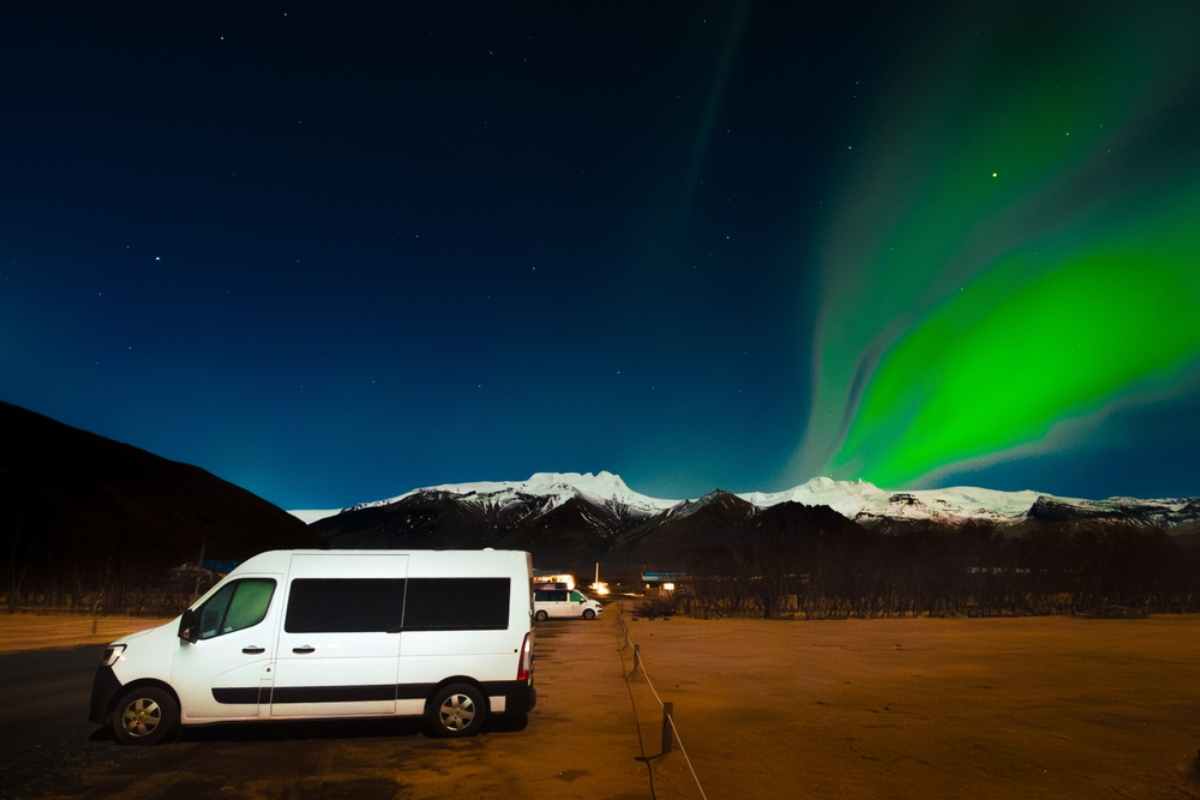
Best for Exploring Remote Northern Lights Spots
If your idea of a good time includes dodging tourist crowds and finding the darkest skies possible, you’ll need a proper 4x4.
- Jeep Compass 4x4 Roof Tent (Automatic) – A great balance of off-road capability and comfort. Plus, the roof tent keeps you away from the cold ground, which is always a win.
- Renault Kadjar 4x4 Roof Tent (Automatic) – Slightly more space and still built to handle Iceland’s unpredictable roads.
- Jeep Wrangler 4x4 Roof Tent (Automatic) – If you want to feel like an Arctic explorer, this is the one. Takes on highland roads like a beast and gets you to the most remote Northern Light spots.
- Toyota Hilux 4x4 Camper (Automatic) – More space, more comfort, and still rugged enough to handle F-Roads. Perfect if you’re traveling with friends or just really like legroom.
- Mercedes Campstar 4x4 Camper (Automatic) – More of a home on wheels than a camper. Sleeps three and lets you enjoy the northern lights without sacrificing comfort.
Best for: Anyone who thinks paved roads are boring and wants the best shot at finding clear skies.
Best for Comfort and Extra Space
If you like your road trips with a little extra breathing room, these are the way to go.
- Renault Trafic Camper (Manual) – Sleeps three, easy to drive, and won’t make you feel like you’re living in a shoebox.
- Renault Trafic Plus (Automatic) – Newer model, automatic transmission, and a smooth ride. Great for anyone who wants an easy drive without giving up space.
- Renault Master Plus (Manual) – Sleeps five, which means you can bring the whole crew. Or just enjoy a little extra room if you like to stretch out.
- Renault Master Camper (Automatic) – The biggest and most comfortable option. If you want a full campervan setup with all the extras, this is it.
Best for: Families, groups, or anyone who believes that road trips should come with a little luxury.
Still Not Sure? Here’s a Quick Breakdown
|
Camper Type |
Best For |
Seats/Sleeps |
F-Road Access? |
Transmission |
Price per Day (USD) |
|
Dacia Duster 4x4 Roof Tent |
Budget travelers, F-Roads |
5 / 2 |
Yes |
Manual |
96 |
|
VW Caddy Camper (Auto) |
Budget travelers, easy driving |
5 / 2 |
No |
Auto |
104 |
|
Jeep Compass 4x4 Roof Tent |
Off-road & remote spots |
4 / 2 |
Yes |
Auto |
141 |
|
Toyota Hilux 4x4 Camper |
Groups, off-road travel |
4 / 4 |
Yes |
Auto |
207 |
|
Renault Master Camper (Auto) |
Families & max comfort |
5 / 5 |
No |
Auto |
358 |
Best Campervan Campsites for Northern Lights Viewing
Not all campsites are great for aurora hunting. These five spots check all the boxes:
- Camping Selfoss – Close enough to town for a snack run, but far enough to avoid streetlights ruining your view. Basic facilities include restrooms, wheelchair access, and nearby hot showers.
- Camping Thingvellir – Smack in the middle of Thingvellir National Park, which means zero light pollution and a view straight out of a Viking saga. Facilities? Restrooms, picnic tables, and seasonal showers (just don’t expect luxury).
- Skaftafell Campground – If watching the northern lights surrounded by glaciers and waterfalls sounds like your kind of thing, this is the spot. Includes hot showers, cooking shelters, and electricity.
- Reykjavík Eco Campsite – Not the darkest place, but if you like WiFi and hot showers while planning your next move, it works.
- Skjól Camping – Near Geysir and Gullfoss, meaning your northern lights show comes with epic scenery and fewer crowds.
Book early, especially for Thingvellir and Skaftafell, as these fill up quickly.
Campervan-Friendly Northern Lights Itinerary
Here’s a flexible 3 to 5-day itinerary designed for aurora hunting with your campervan, complete with escape routes when the clouds roll in.
Day 1: Reykjavik to Þingvellir National Park
- Start in Reykjavik. Stroll around, grab some food, and if you’re feeling extra, hit the Blue Lagoon before heading out.
- Drive 45 minutes to Þingvellir National Park. Walk between tectonic plates, soak in some Viking history, and scope out a good northern lights spot.
- Camp at Camping Thingvellir. If the sky is clear, stay up. If it’s cloudy, remind yourself that Iceland’s weather does what it wants.
Day 2: Golden Circle and Laugarvatn
- Knock out the Golden Circle. Watch Geysir explode, check out Gullfoss, and wonder why people don’t talk about Iceland’s wind more.
- Drive to Laugarvatn Fontana. No light pollution, no crowds, just a great spot for the Northern Lights.
- Camp at Camping Selfoss. If the aurora doesn’t show, at least you’re in a quiet spot.
Day 3: South Coast and Vík
- Drive the South Coast. Stop at Seljalandsfoss and Skógafoss because you can’t come to Iceland and not see these waterfalls.
- Make it to Vík and check out the black sand beach. If the skies clear up, this is one of the best places to catch the lights.
- Camp at Vík Campsite and hope for a clear night. If not, you’ve still got unreal scenery.
Day 4 (Optional): Jökulsárlón and Vatnajökull National Park
- Head east to Jökulsárlón Glacier Lagoon, where icebergs float around like they own the place.
- Explore Vatnajökull National Park. If you’re up for it, book an ice cave tour during the day.
- Camp at Skaftafell Campground and wait for the aurora. If nothing happens, at least you’re sleeping in a spot with glacier views.

Backup Spots for Bad Weather
If clouds roll in, try these instead.
- Grótta Lighthouse – Close to Reykjavik. Not the darkest, but a quick escape from city lights.
- Kleifarvatn Lake – A remote spot on the Reykjanes Peninsula with open skies and no distractions.
- Akureyri – If the south is a mess, head north. Akureyri gets clearer skies and fewer crowds.
FAQs About the Northern Lights in Iceland
Can you see the Northern Lights in Reykjavik?
Yes, you can, but visibility is limited due to city lights. Heading to darker spots like Seltjarnarnes Nature Reserve improves your chances.
What months can you see the Northern Lights in Iceland?
You can see the northern lights in Iceland from late September to early April when the nights are long, and the auroras are most active during the dark winter months.
How long do the Northern Lights last each night?
The lights can last anywhere from a few minutes to several hours, depending on solar activity and weather conditions.
What is the best time of year to visit Iceland for Northern Lights?
The best time of year to visit Iceland for northern lights is during winter, especially December and January, for the longest nights and excellent visibility.
When are the Northern Lights visible in Iceland?
The northern lights are visible from late September to early April, with the darkest, clearest nights offering the best chances.

